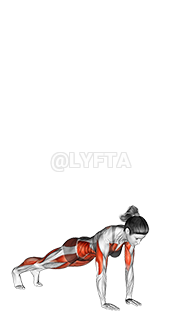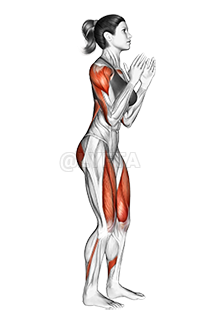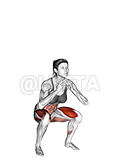
Semi squat Jump
Exercise Profile
Related Exercises:
Introduction to the Semi squat Jump
The Semi Squat Jump is a dynamic exercise that targets and strengthens your lower body muscles, especially the quadriceps, hamstrings, and glutes, while also improving your balance and coordination. It is suitable for athletes and fitness enthusiasts of all levels, from beginners to advanced, due to its adjustable difficulty. Individuals may want to incorporate this exercise into their routine to enhance their explosive power, agility, and overall athletic performance.
Performing the: A Step-by-Step Tutorial Semi squat Jump
- Lower your body into a semi-squat position, keeping your back straight and ensuring your knees don't go beyond your toes.
- Push off your heels and jump vertically as high as you can, swinging your arms upward for momentum.
- Land back softly on your feet, absorbing the impact by immediately going back into the semi-squat position.
- Repeat this process for the desired number of repetitions, maintaining a smooth and continuous motion throughout the exercise.
Tips for Performing Semi squat Jump
- Warm Up: Before you begin any exercise, it's important to warm up your muscles to prevent injury. A good warm-up could include some light cardio, such as jogging or jumping jacks, followed by some dynamic stretching.
- Land Softly: When you land, make sure to do so softly to reduce the impact on your joints. Your knees should be slightly bent when you land. This will help absorb the shock and prevent any knee or ankle injuries.
- Avoid Leaning Forward: A common mistake is leaning too far forward during the jump or the landing.
Semi squat Jump FAQs
Can beginners do the Semi squat Jump?
Yes, beginners can definitely do the Semi Squat Jump exercise. However, it's important to start with a lighter intensity and gradually increase it as your strength and stamina improve. If you're new to exercise, it may be beneficial to have a trainer or coach guide you to ensure you're using the correct form and technique to avoid injury. Always remember to warm up before starting any exercise routine.
What are common variations of the Semi squat Jump?
- The Box Jump: This variation incorporates a box or platform, where the individual jumps onto and off of it, increasing the intensity of the exercise.
- The Broad Jump: This variation involves jumping forward as far as possible, rather than straight up, working different muscle groups.
- The Single-Leg Squat Jump: This variation requires the individual to jump off and land on one leg, increasing the challenge and focusing on balance and stability.
- The Depth Jump: This advanced variation involves stepping off a box or platform and immediately jumping as high as possible upon landing. This helps to improve reactive strength.
What are good complementing exercises for the Semi squat Jump?
- Box Jumps also complement Semi Squat Jumps as they involve similar explosive, plyometric movements that improve lower body strength and power, but with an added challenge of jumping onto a raised platform, increasing the intensity and range of motion.
- Calf Raises can complement Semi Squat Jumps by focusing on the lower leg muscles, particularly the calves, which are used during the jumping phase of the squat. This can help enhance jump height and landing stability in the Semi Squat Jump.
Related keywords for Semi squat Jump
- Body weight cardio exercise
- Semi squat jump workout
- Cardiovascular bodyweight exercise
- Squat jump training
- High-intensity semi squat jumps
- Bodyweight squat jump exercise
- Home cardio workout
- Semi squat jumps for fitness
- Bodyweight cardio training
- Squat jump for heart health











